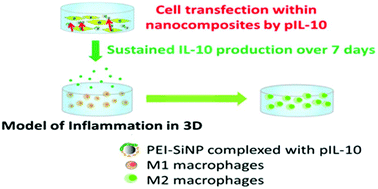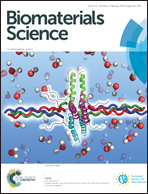Modulating inflammation in a cutaneous chronic wound model by IL-10 released from collagen–silica nanocomposites via gene delivery†
Abstract
Cutaneous chronic wounds remain a major clinical challenge which requires the development of novel wound dressings. Previously, we showed that collagen–silica nanocomposites consisting of polyethyleneimine (PEI)-DNA complexes associated with silica nanoparticles (SiNP), collagen hydrogel and 3T3 fibroblasts, can work as a local “cell factory”. Indeed, the “in-gel” transfection leads to a sustained production and release of biomolecules. Herein, we further explored the possibility for nanocomposites to deliver interleukin-10 (IL-10), a potent anti-inflammatory cytokine, which favors tissue repair. Its anti-inflammatory effect was evaluated in an in vitro inflammation model carried out by LPS (lipopolysaccharide) activation of macrophages embedded in collagen gel. The IL-10 synthesis from nanocomposites was detected over one week in the range of 200–400 pg mL−1 and reached a maximum at day 5 without any observed cytotoxic effects. PEI10-SiNP outperformed free PEI10 and PEI25-SiNP, implying that the introduction of SiNP improved the transfection efficiency of low Mw of PEI. In addition, the structure and mechanical properties of collagen–silica nanocomposites were stable over one week. Subsequently, the ability of nanocomposites to modulate inflammation was tested in a 3D model of inflammation. The decrease of TNF-α and IL-1β gene expression by 20–80% indicated successful inhibition of inflammation by IL-10 released from nanocomposites. Taken together, the nanocomposites are capable of producing effective doses of IL-10 which inhibit the synthesis of pro-inflammatory cytokines and favor the expression of wound healing cytokines. Therefore, the as-constructed 3D gene delivery system represents a promising strategy for the controlled release of therapeutic biomolecules favoring cutaneous wound healing.



 Please wait while we load your content...
Please wait while we load your content...